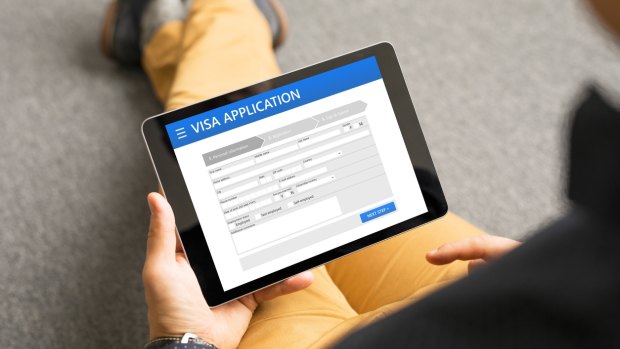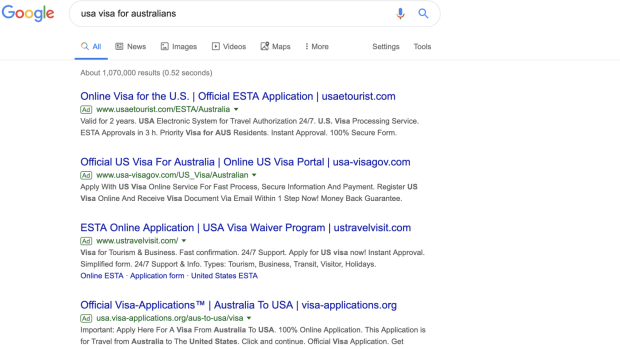This was published 4 years ago
How to recognise the online visa scams catching out Australians
By Michael Gebicki

Authentic e-visa application sites are about as exciting as a brick.Credit: iStock
A family member just paid $180 for an electronic visa for India. The correct price should be $80. She simply Googled "e-visa for India" and clicked on the website at the top of the page. The week before I'd been on a similar site that wanted to charge me $220 for the same e-visa. Scam e-visa websites are everywhere, and it's easy to get caught out.
Google "USA visa waiver for Australians" and the first website at the top of the page is titled "ESTA for Australian citizens". That's a US government information page telling you the conditions for ESTA eligibility, and down the bottom of that page is a link to the US government's ESTA application page. Complete the form and you'll be asked to pay the application fee of $US14. All well and good. Same thing happens if you Google "USA ESTA".
However, when I Google "USA visa for Australians", the first website that comes up on the page is titled "Official ESTA Application U.S. Visa for Australian Citizens". Click on that and you're taken to an official-looking website with a form to fill out. Compete the form right through to the payment page and that'll be $US89. Which means someone is pocketing $US75 for doing nothing but pressing a few buttons. Out of almost 20 websites on that search page, the top four are all commercial websites that add another layer of fees to the visa application process.
In return for this extra fee, these scam sites do nothing more than what the official e-visa website does. The questions on the visa application are exactly the same, the same documentation is required. Nor do they expedite the process. In fact they slow it down because they wait for the payment to clear to their account before forwarding your visa application for approval.

E-visa websites that rip you off
E-visas, or visa waivers that are obtained by completing an online application, have made it possible for scammers to offer their sly and sneaky service, and more and more countries are jumping onto the e-visa wagon.
Google "India visa for Australians" and first up is a link to evisastoindia.org.in, which styles itself as the "Official Indian Visa" website. That's stretching the truth. Apply and if your application is approved you'll get your visa, but you'll pay $100 more than the official Indian e-visa website charges.
Same applies for an Electronic Travel Authorization for Australians to visit Canada, for which the official fee is $C7. Or an e-visa for Cambodia, $US37, or Myanmar, which costs $US50.
How to spot the fraud before you get this far? There's a giveaway on the Google search page. Right beside the link to these fake pages is the word "Ad" inside a small green box. This means someone is paying to have this website advertised. On the Google search page that has the official e-visa websites, there is no "Ad" word.
There are a few exceptions. As well as the websites that pay for higher placement on the page, a Google search will also turn up scam websites that have not paid for advertising, and which do not have the "Ad" box. One such is the iVisa website ivisa.com. However, at the very first step of the visa application process ivisa clearly displays its service fee as well as the actual visa cost, so if you proceed with your application you can't say you weren't warned.
Another sign you're heading into troubled waters: the fake sites tend to look a whole lot flashier. Most official e-visa websites are about as exciting as a house brick. Look-at-me graphics or images are not usual on genuine websites. Bureaucracy at its throttled-back best. If you end up on a page with lots of shouty razzmatazz and heroic bits of national iconography, beware.
If in doubt, go to the bottom of the page on the suspect website. If there's a disclaimer to the effect that this is not associated with the government of country x, do not proceed. In this way these websites have a fig leaf of legality with which to cover their nefarious activity.
Finding your way to the official e-visa websites would be easier if Australia's Department of Foreign Affairs and Trade's Smartraveller website had a simple and easy to find link to the official website on the relevant Smartraveller page. Sometimes they do – thumbs up in the case of India – but for the US the link is buried well down the page and titled "More information: United States Customs and Border Protection". Which is far from intuitive.
The other enabler that allows these scam visa websites to proliferate is Google. Without Google, the fake e-visa facilitators would find it more difficult to market their services. Google allows these websites to pay for higher placement, which puts them above the official e-visa websites on their search response page. Google's defence is that it is just provides the medium, it's not responsible for the message.
That won't wash, as was proven recently in the case of Viagogo. Viagogo is a ticket resale website. Go to its website and you can buy tickets for concerts and sporting events, but at a higher price than that offered by the venue itself. Viagogo has been under mounting pressure from consumer protection regulators, and Google has suspended Viagogo from buying higher placement in search results since it violates Google's advertising conditions. Viagogo is an easier target since the ticket reseller is just one central clearing house for scalper's tickets, while the websites that advertise e-visas for an inflated fee are many.
If you fall for one of these fake websites the rip-off could go much deeper than the excessive fee. The site operator now has all your credit card details. If they're prepared to scam you with a fake visa site, what's to stop them from making merry with your credit card as well?
In 2021 the EU is proposing to introduce a European Travel Information and Authorisation System (ETIAS), a visa-waiver system that will work along the same lines as the US ESTA system applies to Australian passport holders. The cost is just €7, and once approved, you're good to enter the Schengen Area countries for up to 90 days, valid for three years. When it happens, watch the scam merchants pour in.
See also: Why travellers shouldn't fall for 'cash passport' money cards
See also: Six reasons you should never fly a cheap airline in Europe
The real deal – official e-visa websites
Cambodia
Canada
Sign up for the Traveller newsletter
The latest travel news, tips and inspiration delivered to your inbox. Sign up now.